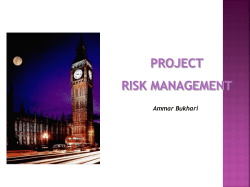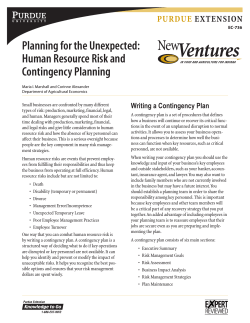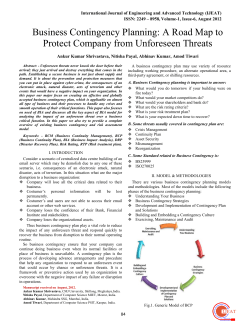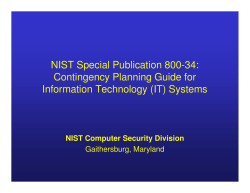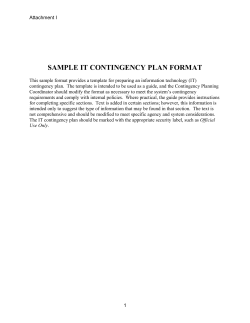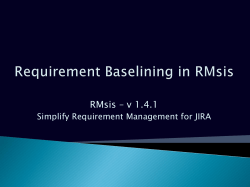
Project Management for Your Local Section / Chapter Lee Stogner, PMP
Project Management for Your Local Section / Chapter Lee Stogner, PMP 2005 Leadership Workshop Tucson, Arizona March 12, 2005 Seminar Objectives To: Provide tools and ideas for more effectively executing your projects In a way that: Develops understanding of the need to execute your projects more effectively So that: Develops understanding of some basic project management principals and practices Promotes teamwork All your organization's projects will be successful Benefits of Sound Project Management Less overall project cost Less strain on working capital Effective use of resources More timely project completion Higher quality of the final product Project Management Overview What is a project? What is project management? What is project success? What factors determine project success? A Project When a task... Has a defined objective Has a deadline Requires integration of knowledge and experience from various organizations PM PM PM PM Project Management is: PM PM PM PM PM PM PM PM PM PM PM PM PM PM PM PM PM Project Management is: Causing a Planned PM Undertaking to Happen PM PM PM PM PM PM PM PM PM PM PM PM Project Management Complex and numerous activities Unique - a one time set of events Finite - a begin and end date Limited resources and budget Many people involved Sequenced activities End product or service must result Program Management Larger in scope than a project Made up of several projects Made up of a number of similar products Programs tend to be more permanent Peanuts What is Project Success? Factors in Project Success Project Management Philosophy Project Management Role and Responsibility Project Management Principles and Practices Project Management Philosophy The “Golden Rule” of Project Management is three words: Plan Organize Control Project Management Roles and Responsibilities Project Execution Maintain Customer Relations Create a Positive Environment Project Execution Plan Project Execution Strategy Project Management Quality Safety Risk Management Design/Develop/Program Implementation Documentation Training Customer Relations Develop Communication Ensure Timely Participation Include the Customer on the Project Team Develop Trust and Confidence Create a Positive Environment __________ Effectively __________ Member of the Team Utilize _______ _______ Activities __________ Success Maintain a safe working environment Safety Project Management Principles and Practices Define Project Objectives Develop Project Execution Plan Define Baselines for Control Manage Risk Close out Effectively Define Project Objectives Expected deliverables Required resources (total installed cost) Required timing (opening date) Safety and Environmental Total Quality Define S.M.A.R.T. Project Objectives S pecific M easurable A ssignable R ealistic T ime related Alignment Process Team Requirements Skills needed ? Individuals identified ? When are they needed ? Where are they ? Training needed ? Interpersonal compatibility ? The Four Cornerstones of Project Management Cost Schedule Scope Quality Cornerstones of Project Management Cost Scope Schedule Quality Scope Poor scope definition is the major contributing factor to cost overruns in the engineering and construction industry. CAUTION Cost Influence Relative Time Initial Scoping Effort Sets the baseline for cost and schedule Must involve the right people Must include implementation Identifies items not included Maximum influence on project cost Breaks project into manageable pieces The WBS Drawings Estimate • Facility • Services WBS Element/ Work Package Schedule Cost Reports Contracts Bill of Materials Successful Work Breakdown Status and completion is easily measured Definite beginning and end It is familiar with prior experience Manageable work assignments One continuous stream of work from start to finish Steps for constructing a WBS Divide the project into major objectives Partition objectives into activities Divide activities with missing characteristics into subactivities Repeat #3 until all subactivities have desired characteristics Lowest subactivities are the basis of work packages Creeping scope The effect of “creeping scope” is a major cause of cost overruns $ To manage creeping scope Keep scope documents current Freeze design after the estimate has been approved Allow only those changes that are justified by benefit Use an effective change management procedure The Four Commandments of Good Project Scope Written Well defined Clearly understood Achievable Cornerstones of Project Management Cost Scope Schedule Quality Aspects of Cost Estimate Cost Control Basis for Control Application of control procedures to follow financial progress Estimate Requirements Define project cost integrate scope, schedule, and resources Define estimate basis Identify potential risks Identify contingency/escalation Identify items not included Elements of Cost Control Establish the baseline (estimate) Measure variation from baseline Take corrective action Cost Control System Detailed project scope/work package Control estimate Chart of accounts Cost status report Forecasting process Change management procedure Cash flow forecast Project Control Project Day 1 -------------To do list: Kick off meeting Project schedule Integration of Cost and Time Basic Elements of the Control System A project plan: Scope, schedule, estimates A monitoring system which measures performance against plan A reporting system which identifies deviations from the plan A system which communicates deviations to the right people Corrective actions Forecasting the project outcome Key Control Philosophies Define the baseline for control 1._______ 2. ________ 3. _______ 4. ________ Divide project into manageable pieces Remember: Ability to influence cost is maximum early in the project Key Control Philosophies (con’t) Define and manage risk/opportunity Integrate scope and estimated cost into schedule Make informed decisions Anticipate deviations/changes Adopt the “end product” approach Plan ahead from phase to phase Basic Project Control Steps Define the project scope Develop a project plan consistent with: project scope estimates (cost constraints) schedule (constraints resources available Report progress and compare with budget and forecast Control by taking corrective action Contingency - Plan for Change Cornerstones of Project Management Cost Schedule Scope Quality Schedule Planning - Identification of the sequence of events necessary to complete the project Scheduling - Determination of timing and assembly of project activities to give overall completion time Front End Schedule A way to get the project started right Design Program Install / Test System Turnover Basis for Project Schedule Project objectives Project scope Project milestones Project estimate (budget) Resource availability The Critical Path Identifies project priorities Shows activity relationships Enables schedule analysis Reflects project strategy Promotes teamwork Basic Network Diagramming Expanded Network Diagramming The Bar Chart The Gantt Chart Project Schedule - Tools Microsoft Project Project Schedule - Tools www.primavera.com Five Phases of Project Management Cornerstones of Project Management Cost Schedule Scope Quality Total Project Quality Management Quality Assurance Quality Control Total Project Quality Management Continuous Improvement Design Basis Project Quality Improvement Develop a quality management plan early in the project Include representatives from all affected organizational units on the project team Initiate the project effectively through kick-off and alignment meetings Review performance and measure success Project Quality Improvement (con’t) Define scope and review periodically Limit scope changes formal change procedure require justification Complete more engineering up-front before defining cost and scheduling Obtain constructability, operability and maintainability input to design Cost of Quality Risk Management Manage Risk What is risk? Sources of risk Kinds of risk Risk Management Process Identify risks Define consequences Develop a mitigation plan Document Sources of Risk Technical Financial Socio-Economic Contractual Risk Management Process Identify Risk Analyze Risk Respond to Risk Document Risk Sources of Help to Identify Risk Site investigations Contract documents Schedule Team brainstorming Body of experience Risk Control Methods Avoid Reduce Share Insure Accept with contingency without contingency Contain Risk Containment Clearly define insurance responsibilities in contracts Use qualified personnel Document and communicate project strategy Define roles and responsibilities Prepare contingency plans for critical activities Use up-front team building Risk Containment (con’t) Use qualifies contractors and vendors Preconstruction work briefings (especially safety) Rehearse critical activities or use mock-ups Use strong project control systems Manage contingency Project Close-out Project Closeout - Major Phases Obtain client acceptance Document the project Conduct the post implementation audit Issue the final report Pyramid Cartoon Successful Project Management Plan the Work… Work the Plan Successful Project Completion Project Management - Learning More www.pmi.org Project Management - Learning More Project Management Body of Knowledge Project Management - Learning More www.amazon.com Project Management - Get Certified www.pmi.org Project Management - IEEE EMS www.ewh.ieee.org/soc/ems Class Exercise - Plan a Project Lee Stogner - Contact Information Lee Stogner, PMP Rockwell Automation Mobile 864-360-9415 Email l.stogner@ieee.org
© Copyright 2025



